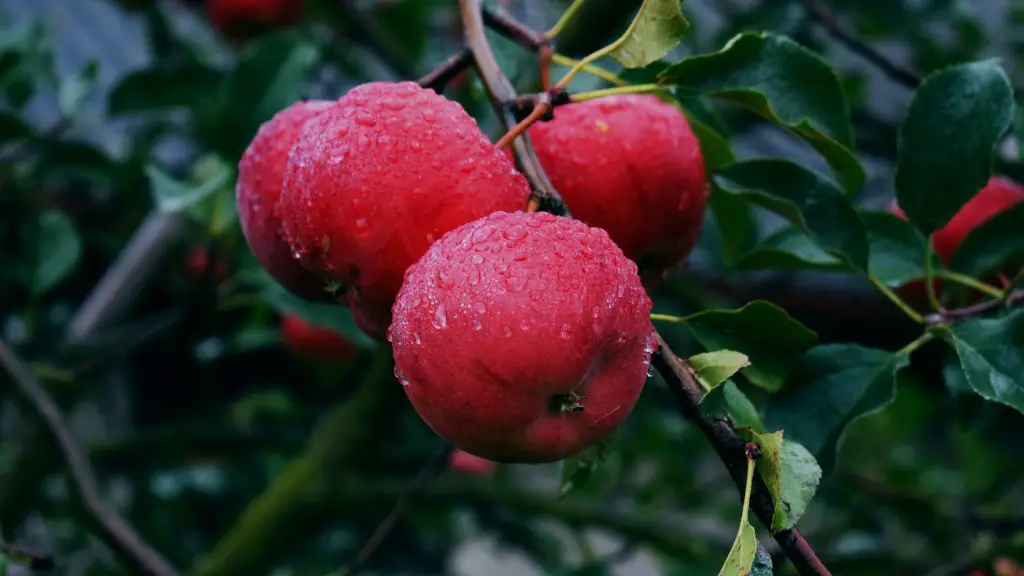It is no secret that avocados are popular. Whether you like them in salads or guacamole, much of the world is obsessed with avocado-mania. But when it comes to growing the crop, how long does it take for an avocado tree to bear fruit? Well, the answer depends on many different factors, but it is generally not a quick process and might take anywhere from three to seven years.
To understand the length of time it takes for an avocado tree to fruit, it’s important to consider the different types of avocado trees, their growing conditions, climate, and the location of the tree in relation to other trees. For instance, there are two main types of avocado trees—West Indian and Guatemalan. West Indian avocados are considered subtropical, and they prefer warm climates and light soils, making California or Florida a good place to grow them. Guatemalan avocados, on the other hand, prefer cooler climates, so the Northern half of the United States is better for growing those. In the Central Valley of California, it’s possible to grow both types of avocado trees.
In addition to the different types of avocados, the growing conditions determine how long it takes for a tree to start producing fruit. If a tree is planted in a sunny spot and receives enough rain and nutrients, it will typically take three to five years to bear fruit. If the tree is planted in a shady spot, it’ll take five to seven years before it produces fruit. Trees that are planted in less ideal conditions, such as in soils that are too hot or too cold, will take a few more years to bear fruit.
In addition, the size of the avocado tree plays a role in how long it takes for the tree to produce fruit. A tree that is planted from a seed will take much longer to bear fruit than a tree that is planted from a piece of mature wood. Small trees also take longer to bear fruit than larger trees. That’s why it’s important to choose a type of avocado tree that is suited to the climate and soil where you plan to plant it.
Finally, the location of the tree in relation to other avocado trees affects the amount of time it takes to bear fruit. The reason is that avocado trees rely on cross-pollination from other nearby trees in order to produce fruit. So if there are no other avocado trees, it may take longer for the tree to bear fruit than if it was located near other avocado trees.
In conclusion, it takes anywhere from three to seven years for an avocado tree to bear fruit, depending on the type of avocado tree, growing conditions, climate, and proximity to other avocado trees. While it’s not a quick process, it is worth the wait when you can enjoy your own home-grown avocados.
Threats to Avocados
Avocado crops can be threatened by numerous insects, pathogens, and environmental events. For example, the avocado lace bug is a type of insect that feeds on the leaves of avocado trees, resulting in leaf stipple, discoloration, and eventual death of the plant if left unchecked. Additionally, avocado trees can be susceptible to fungal diseases, such as anthracnose, charcoal rot, phytophthora root rot, and botrytis fruit rot. Many of these issues can be prevented by proper maintenance and pruning, but if not addressed quickly, the effects can be devastating.
Environmental events, such as harsh winters, can also damage avocado trees and cause them to produce poorly or not at all. In certain locations, such as in Mexico, the effects of global climate change have been causing extreme droughts, which dramatically reduce yields for avocado farmers. Finally, avocado fruits can be vulnerable to pests, such as borers and fruit fly, as well as birds and other animals.
These threats can all be addressed with preventative measures such as crop rotation, pest control, and proper irrigation. These measures help to reduce the risks associated with growing avocados, thus increasing the chances of a successful crop.
In addition to the threats, there are other issues that can impact the growth and production of avocado trees. Diseases and pests can impact the quality and yield of the crop, while environmental events can destroy entire crops. Farmers must be vigilant in their efforts to protect their crops, and they must be willing to take steps to prevent and address any problems that arise.
With proper maintenance and vigilance, avocado farmers can protect their crops and maximize their yields. Despite the associated risks, the rewards of growing avocados can be great, and with the right care and attention, the process of growing avocados can be a rewarding and successful venture.
Types of Avocado
Avocado trees come in many varieties, with each variety producing a different type of avocado fruit. The most common type is the Hass avocado, which is a popular variety with dark-green, leathery skin. There are also “green gold”, “green skin”, and “pinkerton” varieties, which are smaller and have lighter skin. Other types include the Fuerte, Bacon, and Zutano varieties, which all have green skin and white flesh.
The avocado fruit can be harvested when it is ripe, which is usually when the skin turns mostly black, or when the skin turns a pale yellow. While ripe avocados are soft to the touch and can be picked easily, they must be processed within a few days of harvest or they will begin to spoil. Therefore, it is important to pick the fruit when it is ready, as avocados do not ripen on the tree.
Avocado fruits have distinct flavors and textures, which makes them popular in a variety of dishes. This unique combination of texture and flavor is one of the reasons why avocados are so popular in cooking. They can be used in salads, soups, guacamole, or eaten on their own. They can also be used to make ice cream, smoothies, and other desserts.
Avocado fruits are also known for their abundance of health benefits. Avocados are rich in monounsaturated fat, fiber, and numerous vitamins and minerals, making them an excellent source of nutrition. Additionally, avocados are high in antioxidants, which can help protect against disease and promote overall health.
No matter which type of avocado tree is chosen, it is important to select one that is adapted to the climate, soil, and other growing conditions in a particular region. To get the highest possible yields, farmers should select the right variety of avocado and pay attention to the health and maintenance of the tree.
Growing Avocado Trees
The process of growing avocado trees can be complicated, requiring knowledge of the growing conditions, climate, and other factors. For best results, the avocado tree should be planted in a well-drained soil and should receive at least six hours of direct sunlight a day. Additionally, avocado trees should be regularly pruned, watered, and fertilized in order to stay healthy and produce fruit.
Avocado trees can be planted from seed, cuttings, or purchased from a nursery. When planting from seed, it is important to use fresh seeds, as old seeds will not germinate. The tree should be planted at a shallow depth in order to encourage the root system to establish quickly and the tree should receive frequent irrigation until the roots are established.
It is also important to note that avocado trees require regular pruning and shaping in order to promote healthy growth and production. Pruning and shaping should occur several times a year to ensure the tree produces the highest yields possible, and to prevent any diseases or pests from affecting the tree. At the same time, it is important not to over-prune the tree, as this can damage the tree and reduce the number of fruits produced.
Finally, fertilizer should be applied regularly in order to provide the tree with the nutrients needed for healthy growth and production. Most commercial fertilizer is designed to meet the needs of avocado trees, but if desired, compost or manure can also be used. Additionally, the soil should be tested regularly to ensure that it is still suitable for the tree.
Harvesting Avocado
Once an avocado tree has reached the right age, size, and maturity, it is time to harvest the fruits. The best time to harvest is when the fruits are slightly soft; they are not yet ripe, but they are not hard either. The fruits should be picked with care to avoid damaging the tree and to ensure the highest quality fruit. Additionally, the fruits should be harvested in the middle of the day, in order to avoid the heat of the sun.
After harvesting, the fruits can be stored for a few days or weeks before they are consumed. Unripe avocados can be stored in a cool, dry location and will eventually ripen with time. Ripe avocados should be used within a couple of days for the best taste and texture.
If desired, avocados can also be frozen for later use. The fruits should be peeled, seeded, and mashed before freezing and can be stored in an airtight container in the freezer for up to six months. Frozen avocados can be thawed and used in a variety of dishes, such as guacamole or smoothies.
Avocado Varieties
While the most popular variety of avocado is the Hass, there are numerous other varieties that are grown around the world. In Mexico, the most widely grown variety is the Del Rio, which has a thick, creamy texture and is often used for culinary purposes. Other popular varieties include the Choquette, Fuerte, Gwen, and Sharwill, which are all well-suited for making guacamole.
In addition to the widely-available Hass avocados, there are several other varieties that are more difficult to find. These include the Fuerte, Bacon, and Zutano, which have green skin and white flesh, as well as the Gwen, Choquette, and Sharwill, which have green skin and yellow flesh. These varieties are less common in the United States, but they can be found in specialty stores or online.
Avocado varieties differ in size, texture, flavor, and uses. For example, some varieties like the Del Rio are better suited to making guacamole, while others like the Bacon and Gwen are more suitable for salads and other dishes. Additionally, some varieties like the Del Rio and Gwen are prized for their milky, creamy texture, while others like the Bacon and Fuerte are prized for their firmer texture.
No matter which type of avocado tree is planted, one thing is certain – the process of growing avocados can be rewarding, and the final product can be delicious and nutritious.



